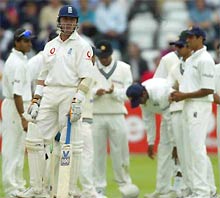Floundering in negativity
Daniel Laidlaw
Another away series, another example of the mediocrity of what passes for
India's seam attack. If the first Test revealed an inability to build and
maintain pressure, then the second has shown an outright deficiency in
performing to a standard capable of achieving more than allowing respectable
opposition to comfortably compile big totals.
Bowlers win Tests and India's group don't have the wickets on the board.
Even given outstanding series by the leading batsmen, which was far from
guaranteed against England's under-rated attack, series success with Khan,
Nehra and Agarkar was highly optimistic. Collectively they had played only
35 Tests before the series, none in England. Unless dramatic progress was
made by one of the three or the unit as a whole demonstrated an unlikely
level of discipline and intensity, then dismissing England's confident
batting order for competitive scores often enough to win the series was
unrealistic.
Even in the unsurprising event of that failing to happen, though, conceding
619 speaks of more than a fundamental lack of quality, which is the
essential reason for India's bowling woes. Despite Vaughan's superlative
knock, there was still scope for a weak but hard-working side to dismiss
England for a lead of around 100 and conceivably put them under some
pressure on the last day.
Instead, what transpired was the type of disillusioned, uninspired cricket
one might expect in a dead match or already lost series. Having apparently
conceded England could not be bowled out with a small enough lead to make
second innings runs relevant, both teams disturbingly appeared to play with
the same aim; England wanting to build their lead and India content to have
them use up overs while waiting for the light to deteriorate.
 Even for an ordinary bowling team, this sort of negativity should be a last
resort. Zaheer Khan bowling Flintoff and Stewart in the same over showed a
hint of potency remained, but India too readily lapsed into going through
the motions, for which the blame has to lie mainly with Ganguly. Poor
bowling is one thing, but it's incumbent upon the captain to foster the
right attitude and prolonging the stay in the field doesn't qualify.
Even for an ordinary bowling team, this sort of negativity should be a last
resort. Zaheer Khan bowling Flintoff and Stewart in the same over showed a
hint of potency remained, but India too readily lapsed into going through
the motions, for which the blame has to lie mainly with Ganguly. Poor
bowling is one thing, but it's incumbent upon the captain to foster the
right attitude and prolonging the stay in the field doesn't qualify.
As so often happens, the defeatist mentality carried over to the batting
with the loss of two quick wickets, immediately undermining anything that
could have been achieved by extending England's innings.
Despite the positive run rates, neither team has appeared overly keen to
seize the match, which has showcased more than one of cricket's negative
aspects. The regulation governing bad light is one that needs examining to
increase the attractiveness of Test cricket.
On day one, India accepted the light an hour before scheduled stumps when
Laxman had some momentum. And on day three, England decided to come off an
hour past stumps when they could have punished a tired India. Both were
reasonable decisions at each team's discretion, but it's time teams were no
longer given the option of stopping play for poor light.
In a match like the second Test where the quality of light has been a
recurring problem, both sides are affected over the course of five days. Why
less-than-ideal natural viewing conditions should be considered different to
variable bounce, a damp outfield, extreme heat or any other uncontrollable
circumstance to which players can reasonably adapt is puzzling.
If the safety of the players was endangered, then one could understand the
umpires making a decision to suspend play. Other than in that circumstance,
though, poor light should be considered part of the game, particularly
during scheduled playing hours.
Suspending play for light might also be a little more palatable if
over-rates were not so tardy. But it seems strange that one negative, a slow
over-rate, should be balanced with another in allowing the batsmen to go
off, which shows neither team are really interested in playing. India could
labour through their overs on day four in the knowledge that when it came
their turn to bat they could eventually accept the light, an advantage they
did not deserve.
At grounds equipped with light towers, this is no longer an issue. Without
them, for the sake of the spectacle, it should be incumbent upon teams to
make the best of it.
 Also a poor advertisement for cricket was the non-catch of Alec Stewart by
Virender Sehwag, yet another of the endless series of examples of why
catching decisions should not be referred to the third umpire. As it stands
now, the existing regulations in effect make it illegal for a fielder to
take a catch with his hands touching the ground. This point needs to be
acknowledged, because it has almost reached the farcical stage where
fielders may as well save their energy and not bother to dive for low
catches.
Also a poor advertisement for cricket was the non-catch of Alec Stewart by
Virender Sehwag, yet another of the endless series of examples of why
catching decisions should not be referred to the third umpire. As it stands
now, the existing regulations in effect make it illegal for a fielder to
take a catch with his hands touching the ground. This point needs to be
acknowledged, because it has almost reached the farcical stage where
fielders may as well save their energy and not bother to dive for low
catches.
Unless instances of cheating have coincidentally increased manifold to match
the extended use of replays to decide catches, hardly likely given the
nature of replays, then the invariable not out decisions are the fault of
no-one but the system. Umpires, batsmen and fielders are doing their jobs
correctly. It is simply that TV replays cannot be relied upon to provide an
accurate picture, for it will always appear from certain angles that the
ball has bounced when instinct, of the fielders and probably the field
umpires, knows the catch to be clean.
The fallibility of the camera lens has to be admitted to make close catches
legal again.
More Columns
Mail Daniel Laidlaw